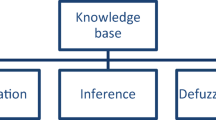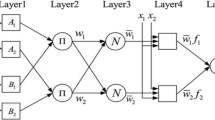Abstract
To understand the decomposition behavior of biomass oxidation, there is need to analyze the process by some models. An e-tracking system was established and modeled by the object-oriented methodology of kinetic parameters of biomass oxidation. The system calculates kinetic parameters of the biomass oxidation through neuro-fuzzy methodology which is the main core of the e-tracking system. The main attempt in this study was to develop a model for tracking of the biomass oxidation based on different input features. Activation energy and reaction order were the kinetic parameters of the biomass oxidation which were used as the output parameters. Fixed carbon and ash are the most influential factors for the activation energy and reaction order respectively. Oxygen concertation has the smallest impact on the activation energy and reaction order. Designed e-tracking system could have potential for practical applications since it could be updated with more input parameters.






Similar content being viewed by others
References
Ding Y, Huang B, Wu C, He Q, Lu K (2019) Kinetic model and parameters study of lignocellulosic biomass oxidative pyrolysis. Energy 181:11–17
Onyelowe KC, Onyelowe FDA, Van DB, Ikpa C, Salahudeen AB, Eberemu AO, Amadi AA (2019) Valorization and sequestration of hydrogen gas from biomass combustion in solid waste incineration NaOH oxides of carbon entrapment model (SWI-NaOH-OCE Model). Mater Sci Energy Technol
Ali S, Sørensen K, Nielsen MP (2019) Modeling a novel combined solid oxide electrolysis cell (SOEC)-biomass gasification renewable methanol production system. Renew Energy
Asiedu NY, Neba FA, Addo A (2019) Modeling the attainable regions for catalytic oxidation of renewable biomass to specialty chemicals: waste biomass to carboxylic acids. S Afr J Chem Eng 30:1–14
Santhanam S, Schilt C, Turker B, Woudstra T, Aravind PV (2016) Thermodynamic modeling and evaluation of high efficiency heat pipe integrated biomass Gasifier–Solid Oxide Fuel Cells–Gas Turbine systems. Energy 109:751–764
Jin H, Lu Y, Guo L, Cao C, Zhang X (2010) Hydrogen production by partial oxidative gasification of biomass and its model compounds in supercritical water. Int J Hydrog Energy 35(7):3001–3010
El-Emam RS, Dincer I (2015) Thermal modeling and efficiency assessment of an integrated biomass gasification and solid oxide fuel cell system. Int J Hydrog Energy 40(24):7694–7706
Jia J, Abudula A, Wei L, Sun B, Shi Y (2015) Thermodynamic modeling of an integrated biomass gasification and solid oxide fuel cell system. Renew Energy 81:400–410
Zhao Y, Zhu G, Cheng Z (2010) Thermal analysis and kinetic modeling of manganese oxide ore reduction using biomass straw as reductant. Hydrometallurgy 105(1-2):96–102
Karlström O, Hupa L (2019) Energy conversion of biomass char: oxidation rates in mixtures of O2/CO2/H2O. Energy 181:615–624
Jang JS (1993) ANFIS: adaptive-network-based fuzzy inference system. IEEE Trans Syst Man Cybern 23(3):665–685
Lethbridge TC, Laganiere R (2005) Object-oriented software engineering. McGraw-Hill, New York
Jacobson I (1993) Object-oriented software engineering: a use case driven approach. Pearson Educ India
Sunphorka S, Chalermsinsuwan B, Piumsomboon P (2017) Application of artificial neural network for kinetic parameters prediction of biomass oxidation from biomass properties. J Energy Inst 90(1):51–61
Petković D, Ćojbašič Ž, Nikolić V (2013) Adaptive neuro-fuzzy approach for wind turbine power coefficient estimation. Renew Sust Energ Rev 28:191–195
Petković D, Pavlović NT, Ćojbašić Ž (2016) Wind farm efficiency by adaptive neuro-fuzzy strategy. Int J Electr Power Energy Syst 81:215–221
Petković B, Petković D, Kuzman B, Milovančević M, Wakil K, Ho LS, Jermsittiparsert K (2020) Neuro-fuzzy estimation of reference crop evapotranspiration by neuro fuzzy logic based on weather conditions. Comput Electron Agric 173:105358
Petković B, Petković D, Kuzman B (2020) Adaptive neuro fuzzy predictive models of agricultural biomass standard entropy and chemical exergy based on principal component analysis. Biomass Convers Bioref 1–11
Author information
Authors and Affiliations
Corresponding author
Additional information
Publisher’s Note
Springer Nature remains neutral with regard to jurisdictional claims in published maps and institutional affiliations.
Rights and permissions
About this article
Cite this article
Petkovic, D., Petković, B. & Kuzman, B. Appraisal of information system for evaluation of kinetic parameters of biomass oxidation. Biomass Conv. Bioref. 13, 777–785 (2023). https://doi.org/10.1007/s13399-020-01014-3
Received:
Revised:
Accepted:
Published:
Issue Date:
DOI: https://doi.org/10.1007/s13399-020-01014-3




